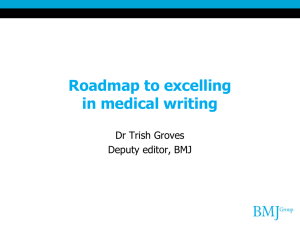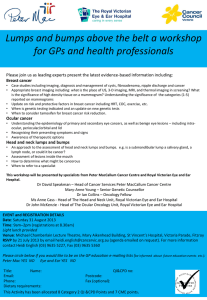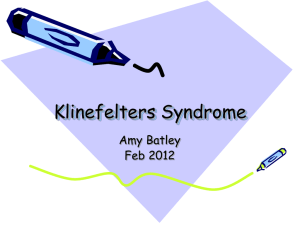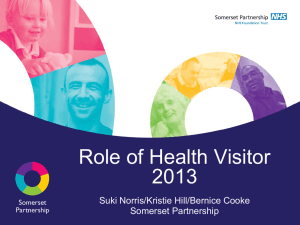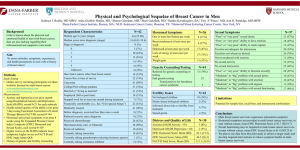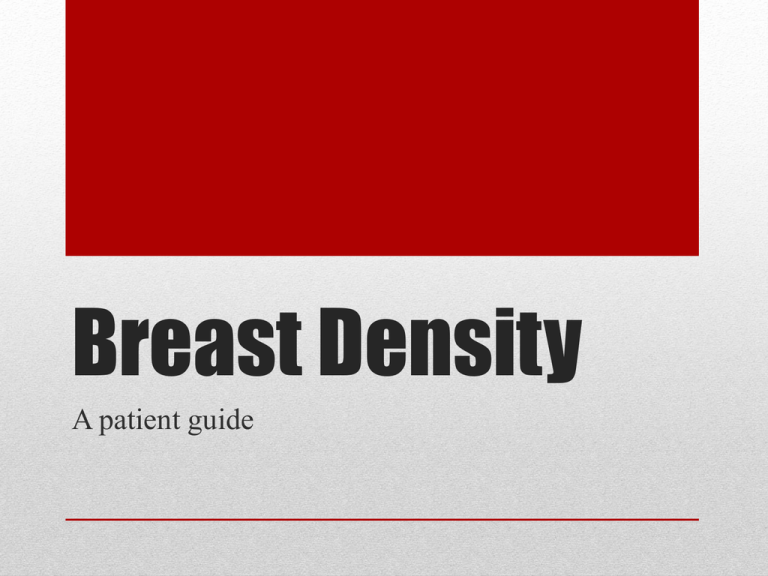
Breast Density
A patient guide
• Breast Density refers to the amount of fatty tissue and
fibro-glandular tissue seen in the breast by mammogram.
This is not something that can be felt on clinical breast
exam. Breast Density is categorized into four different
levels.
•
•
•
•
Fatty – 10% of women
Scattered fibroglandular density – 40% of women
Heterogeneously dense – 40% of women
Extremely dense – 10% of women
What is Breast Density?
• Approximately 50% of women undergoing screening
mammography are classified as having either "heterogeneously
dense" or "extremely dense" breasts. For all of these women,
the patient letter will inform them that they have "dense breast
tissue." This is significant because the denser the tissue is it
may make it more difficult to detect breast cancer (masking).
The sensitivity of the mammogram (chance that disease will be
detected) decreases with increasing density. Mammogram,
however, is still recommended as a screening for breast cancer
as there are many breast cancers that can only be detected by
mammogram.
Dense Breast Tissue
• It is important to understand that every woman’s risk of
breast cancer increases with age. The risk of being
diagnosed with breast cancer during the next ten years of
your life is as follows:
• -Age 30:
0.44% 1 in 227
• -Age 40: 1.47% 1 in 68
• -Age 50:
2.38% 1 in 42
• -Age 60:
3.56% 1 in 28
• -Age 70:
3.82% 1 in 26
What is the risk of Breast Cancer
by age?
• Having Dense Breasts is considered a risk factor for breast
cancer. Only 10% of all women have "extremely dense" breast
tissue, which is associated with a relative risk of breast cancer
of approximately 2 compared with average breast density.
This means at the age of 50 instead of having the 1 in 42
chance of breast cancer, the risk is 1 in 21.
• Forty percent of women have "heterogeneously dense" breast
tissue, which is associated with a relative risk of approximately
1.2. This means at the age of 50 instead of having the 1 in 42
chance of breast cancer, the risk is 1 in 35. Therefore, breast
density is not a major cancer risk factor.
How does Breast Density affect Breast
Cancer Risk?
• A person’s overall risk of breast cancer depends upon other
risk factors such as gene mutations, family history, and
personal history. These factors combined with age and density
can aid in deciding what the best breast cancer-screening plan
is on an individual basis. The strongest risk factors for breast
cancer are:
•
•
•
•
Age
Sex
Personal history of atypia on a prior biopsy (ADH, ALH, LCIS)
First degree relative with premenopausal breast or ovarian cancer
Overall risk
• MRI
• Ultrasound
• Tomosynthesis (“3D
Mammogram)
•
What are other breast cancer
screening options are there?
Screening
MRI
• Screening breast MRI has been
shown to substantially increase the
rate of cancer detection.
• It is recommended in patients who
are at very high risk (>20% lifetime
risk) based on American Cancer
Society guidelines.
• For patients at "intermediate risk,"
such as those with a personal history
of breast cancer or a prior biopsy
diagnosis of atypia (equivalent to a
15% to 20% lifetime risk), a patientcentered shared decision-making
approach is recommended
Screening
Breast
Ultrasound
• Screening breast ultrasound has
been known to increase the number
of false-positives. The positive
biopsy rate for lesions detected on
screening mammography is 25% to
40%, while the positive biopsy rate
for lesions found on screening
ultrasound is 5-10%.
• This means that 90% to 95% of
biopsies initiated by the screening
ultrasound in women with negative
mammograms end up showing no
cancer.
Screening
Breast
Tomosynthesis
• Screening breast tomosynthesis (“3D mammography”) increases breast
cancer detection and decreases the
rate of false positives and biopsies,
compared to traditional
mammography, particularly in
women with dense breasts.
• Although the radiation dose of
tomosynthesis is slightly higher than
mammography, it is still within FDA
limits.
ACR
ACOG
• The American College of
Radiology – they encourage
education and awareness of
the public, but do NOT
currently have any
recommendations for any
additional action or
testing.
• The American College of
Obstetricians &
Gynecologists – As of April
2014, they do not
recommend routine use of
alternative or adjunctive test
to screening mammography
in women with dense
breasts who are
asymptomatic and have no
additional risk factors.
Recommendations…
• The New Jersey legislature mandated insurance coverage
for any supplemental breast cancer screening deemed
medically necessary in patients with “Extremely” dense
breasts or those who have other risks factors.
• Currently there are no insurance billing codes for
screening breast ultrasounds or tomosynthesis.
• Screening breast MRI is usually covered for high-risk
women, but not for women at average risk who simply
have dense breasts. Women who desire supplemental
screening (whether it be ultrasound or MRI) may be
asked to pay out of pocket.
Is there insurance coverage for
additional screening?
• The American College of Obstetricians and Gynecologists
Committee Opinion No 593. Management of women with
dense breasts diagnosed by mammography. Obstet Gynecol
2014 April; 123(4); 910-911.
• Lipson JA, Hargreaves J, Price ER et al. Frequently asked
questions about breast density, breast cancer risk and the breast
density notification law in California: A consensus document.
www.breastdensity.info.
• Mass, Sharon. Discussing Breast Density, A Toolkit for the
New Jersey Obstetrician Gynecologist, American Congress of
Obstetrician and Gynecologist, New Jersey Section. May
2014.
References
• If you feel you have risk factors, you may make an
appointment with your doctor to discuss which screening
modality is right for you.
• If you do not have risk factors then yearly screening
mammography starting at age 40 is our current
recommendation.
What next….



